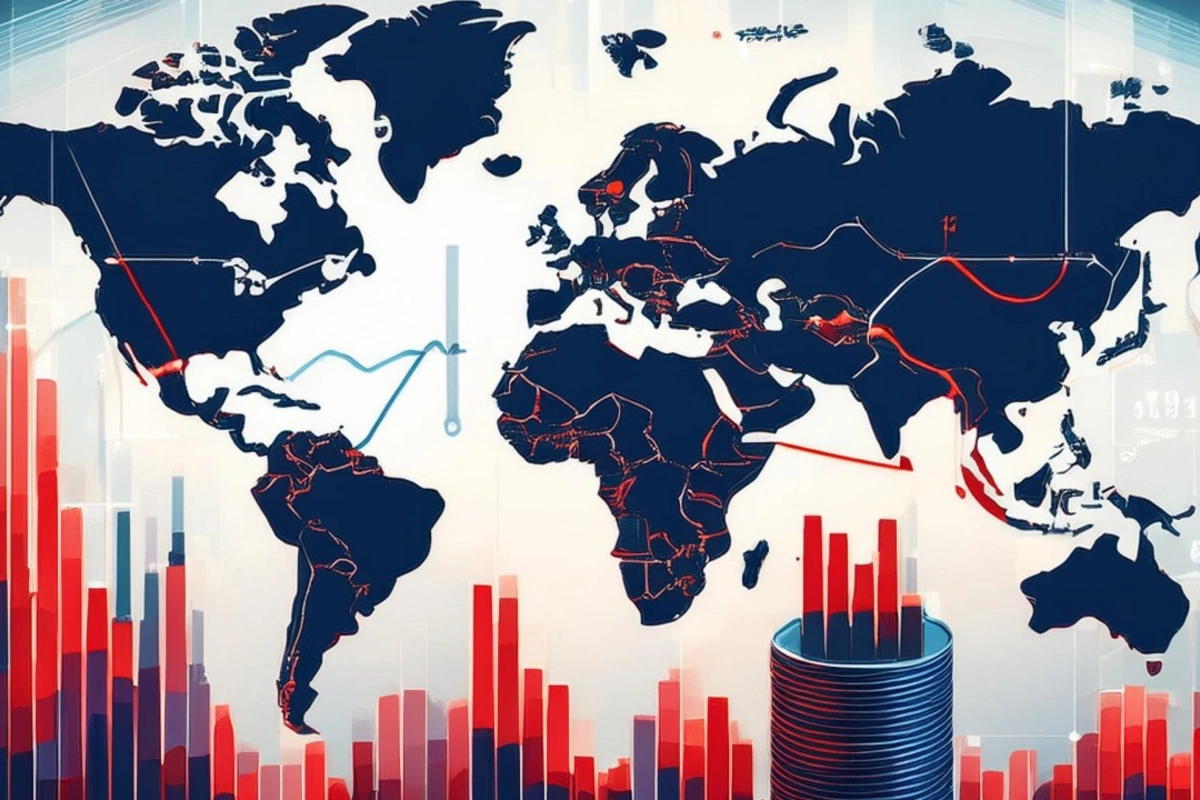
Photo credit: LinkedIn
Geopolitical conflicts-such as military actions, trade wars, sanctions, and political tensions-are significantly damaging economic performance and hindering innovation.
Amid global disruptions such as the pandemic and climate crises, a wave of regional conflicts and the growing confrontation between major powers are creating strong headwinds for growth, The Caspian Post reports citing UzA.
The World Bank warns of severe challenges facing developing countries: weak investment, productivity stagnation, aging populations, and rising geopolitical tensions threaten to turn the next 25 years into a tough struggle for development. The global economy is already showing relatively low growth rates, with forecasts for 2025-2026 projecting only around 2.7-3.0% (IMF, World Bank). Analysts at the IMF and World Bank highlight the escalation of conflicts and rising protectionism as key risks driving further slowdown.
Consequences for Economic Growth
Geopolitical conflicts hinder economic growth through several channels. First, they destroy physical capital and infrastructure (such as roads, factories, and ports) and disrupt supply chains. For example, the IMF considers the mutual tariffs and sanctions as a negative supply shock: production costs increase, competitiveness declines, and GDP is reduced (according to IMF estimates, U.S. tariff increases by early April 2025 lowered U.S. growth by 0.4 percentage points). Global trade turnover, which until now has shown resilience, is projected by the IMF to decline: export growth is expected to reach only about ~1.7% in 2025, compared to 2-3% before the pandemic. This slowdown negatively affects all countries, as global trade has traditionally been a key growth driver.
Second, conflicts lead to rising uncertainty and political risks, which delay investment decisions. According to the World Bank, growing uncertainty and unfavorable trade policies, especially geopolitical frictions, are serious factors lowering growth forecasts. The escalation of trade wars may further hinder short- and long-term growth. Declining business and consumer confidence amid confrontation undermines the effectiveness of some stimulus measures.
Third, military spending increases at the expense of development financing. Historically, it has been observed that countries tend to turn inward, prioritizing defense over development projects after major wars. The reallocation of budgetary resources away from healthcare, education, and infrastructure toward military programs reduces the economy’s overall productivity. Together, these factors result in a long-term reverse development effect: the IMF estimates that, in the absence of conflicts since the 1970s, global GDP in 2014 would have been approximately 12% higher. In other words, geopolitical instability significantly slows global growth.
Key Mechanisms Through Which Conflicts Impact Economic Growth:
Trade barriers and sanctions. Mutual tariffs and embargoes restrain the export/import of goods and technologies, reducing the exchange of ideas and investments. For example, U.S. tariff hikes at the start of 2025 alone have already lowered the global growth forecast by 0.8 percentage points (to 2.8%).
Destruction of infrastructure. Production facilities and transport networks are devastated in war zones, which reduces economic activity for years, while the high reconstruction costs distort long-term growth trajectories.
Rising uncertainty. Amid escalating conflicts, businesses and investors often postpone new projects. This especially harms investment in innovative and high-tech sectors, which are more sensitive to risk.
Resource diversion. Increased spending on the military and security reduces government support for education, science, and infrastructure - traditional drivers of economic growth.
Impact of Conflicts on Innovation
Innovation activity is susceptible to geopolitical shocks. Researchers note that heightened geopolitical risk (an index capturing news on conflicts and sanctions) leads to a noticeable decline in innovation within the corporate sector. An analysis of data from 4,625 publicly listed U.S. companies over 1985-2017 showed that a 1% increase in geopolitical risk results in a 0.18% decrease in the number of patent applications filed the following year. Firms tend to retreat from pioneering, fast-evolving technologies, adopting more conservative strategies during such periods. They reduce R&D investments, shift developers to less risky projects, or even reassign personnel: following spikes in political tension, companies experience increased turnover among researchers and scientists. About 17% of the reduction in patent activity can be attributed to the departure of experienced engineers and scientists from these firms.
Overall, this means that companies begin to invest less in long-term innovation. During periods of instability, they either postpone R&D or redirect resources toward more reliable, profitable today projects. Researchers in a Dominican study published on SSRN emphasize that rising tensions lead to a narrowing of firms’ technological focus: the number of new products and niche, high-risk projects decreases. In contrast, firms aim to preserve cash reserves and retain personnel. Even a short-term spike in conflict can trigger 3-5 years of delayed innovation cycles and slowed technological progress.
Damage to the innovation environment also occurs at the macro level. The breakdown of trade and scientific-technical ties between countries deprives companies of access to cutting-edge ideas and technologies. Economic modeling by Góes and Bekkers (CEPR) shows that under complete isolation of two blocs (for example, China and the West), knowledge flows would decline to such an extent that by 2040, global real income would be about 5% lower than in the baseline scenario. Significantly, the poorest countries within these blocs suffer the most: deprived of high-quality component imports and access to advanced ideas, they lose their potential for innovation-driven development. In Western countries, the losses from breaking ties with the Eastern bloc are largely static (mainly limited to trade barriers). At the same time, developing economies lose future growth due to missed knowledge transfers.
Furthermore, conflicts erode the institutional foundation for innovation. Increased corruption, weakened intellectual property protection, and reduced trust in relations sharply worsen the business climate, causing investors to shy away from high-value-added projects.
Examples of the Impact of Conflicts on Innovation:
Patent Activity and R&D. As noted earlier, rising risks are linked to a decline in the number of new patents. Research shows this decline is primarily driven by the loss of human capital (the outflow of scientists) rather than cuts in R&D budgets.
Types of Innovation. The World Bank analyzed firms in Africa and the Middle East and found that companies introducing new products in peacetime contribute to employment growth (+1.7 percentage points). However, in conflict zones, they instead lose jobs (-4.6 percentage points). On the other hand, automation (process innovations) in peaceful settings tends to reduce employment (-2.0 percentage points), but under wartime conditions, it stimulates hiring (+5.1 percentage points). This illustrates that in active conflict zones, firms tend to focus on simple technological improvements (such as boosting production efficiency) rather than undertaking risky research or developing new products.
Technological Diversification. Under geopolitical market fragmentation, barriers to knowledge exchange rise. For example, restrictions on the export of advanced semiconductors or AI technologies hinder the functioning of global R&D chains. CEPR symposium findings show that countries cut off from leading partners are forced to rely on less efficient imports, which lowers the overall quality of innovation.
Thus, conflicts generate a technological famine: even if specific sectors (such as defense) may receive a short-term boost, the overall flow of innovation slows down. Firms reduce long-term development investments, avoid multidisciplinary approaches, and focus on survival strategies. Global experience shows that periods of Cold War and regional conflicts were typically accompanied by the isolation of blocked countries from global scientific networks and a slowdown in their technological progress - a notable example being the decline of scientific ties between the USSR and the West in the 1970s-1980s.
Mitigation Measures and Conclusions
The analytical community emphasizes the need for measures to reduce the negative impacts of conflicts. The IMF calls for a stable and predictable trade environment and deepening international cooperation to avoid further growth losses. In particular, lowering tariff barriers and swiftly lifting political technological restrictions would help preserve at least part of the global innovation potential. The World Bank suggests that countries strengthen internal growth drivers: enhancing macroeconomic stability and accelerating investments in education and infrastructure to offset external shocks.
At the same time, the heightened role of geopolitics is already setting new development frameworks. One consequence could be the accelerated creation of domestic science and technology clusters and supply chains within more friendly country alliances, even at the cost of short-term economic inefficiency. Some regions may increasingly strive for greater technological sovereignty. However, even in such scenarios, the economy faces the costs of duplication and reduced knowledge exchange, which will inevitably affect innovation rates and long-term growth.
The geopolitical conflicts of the 2020s have already had a noticeable negative impact on international economic ties and the global innovation environment. Disrupted supply chains, capital outflows, and a reduction in scientific exchange are all symptoms of a broader trend toward the fragmentation of the global economy. Sanctions, trade wars, and visa barriers, used as pressure tools, ultimately hinder knowledge transfer, slow research progress, and undermine the trust necessary for dynamic growth. The most high-tech sectors - semiconductor manufacturing, future energy technologies, defense, and financial technologies - have become the epicenters of these geo-economic fractures, creating parallel markets and ecosystems. Although some countries have managed to turn aspects of the crisis to their advantage (by securing cheaper resources or attracting relocated production), overall, the costs of conflicts for the global innovation system far outweigh the localized gains.
The long-term scenarios raise well-founded concerns. If the formation of isolated blocs continues, the world risks losing a significant share of its potential growth and technological progress. Fragmentation could cut up to 7% from global output, and the breakdown of scientific cooperation threatens to slow progress on shared international challenges, from climate change to emerging diseases. Of course, a full return to the era of total globalization is unlikely, as national security considerations will dictate selective cooperation. However, international institutions, such as the IMF, WTO, World Bank, and OECD, are urging states to maintain targeted engagement in critically important areas. Coordination mechanisms must be adapted to the new reality to withstand the challenges of a fragmented world.
Ultimately, innovation and economic growth thrive most successfully under conditions of peace and openness. History shows that the competition of ideas flourishes through freedom of exchange and cooperation, not through the erection of barriers. No matter how intractable they may seem, geopolitical conflicts should not completely shut down channels of dialogue. Maintaining international scientific contacts, academic mobility, and partial mutual market access is insurance against global stagnation. In a world where humanity faces shared challenges, innovation should not become a casualty of geopolitics. Therefore, the search for a balance between national interests and global well-being is the key strategy to mitigate the adverse effects of conflicts on progress and preserve the foundations of future growth.
Share on social media

